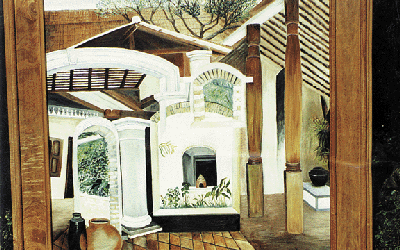

![]()
Looking at Daisy Campbell’s exhibition of paintings, held recently at the Alliance Francaise de Kandy was a pleasure.
The thematic display and its curatorial finesse, I have been told, is the work of a painter friend. But beneath all this sophistication, it is clear that this exhibition, for all its variety of artistic references, its self-conscious styles, and the artist’s stern insistence on her own presence in the works, is at its heart, a simple statement of someone who enjoys making pictures, or, translating into pictures the everyday pleasures of living.
It is all about the reciprocity between art and life. Like Oscar Wilde, it may be said of Daisy that she devotes her talent to art, and her genius to living. Hers is an art activated by some inner principle (or drive?) - so many references to places, things and events.
There is a sliding scale in the paintings of nature, with airy metaphors at one end and literalness at the other. There is a naturalizing and externalizing intent in all her work - recording everything seen, in a sort of a version of Pre- Raphaelite verisimilitude; a sort of "Phenomenalism" which decrees that artists must confine themselves strictly to what is given to the perceiving subject, without making any prior suppositions about any underlying essence in the styles, descriptions or representations and evocations.
 Kotugoda
Walauwa
Kotugoda
Walauwa
In a series of paintings at this exhibition, this most domestic
of artists, surprisingly, has added another visual dimension; one of remarkable
innovation in the depiction of buildings, imaginary and real (the real, mostly
houses of friends as it is to be expected).
With their almost artless fresh appeal, these pictures have something of the significance to architecture of painters of this century such as Mondrian, Van Doesburg, Oeznfant and Leger. Her reductionist approach, showing the front and the back, inside outside, and items of garden and interior decor, in a single cohering design seems to overturn Mies’ famous axiom that more can be less.
Indeed, in her pictures, Daisy deconstructs the house in order that the sum of the selected parts becomes greater than the whole, artistically and visually.
Picasso invented this for the human figure, and made it part of 20th Century visual experience. The Jains in India knew this trick before Picasso, in their renderings of the human face.
By exploiting this device, that has now come to be known as the "further eye" our own George Keyt, in his 1950’s "Girls with Mirrors," produced in these girls that veiled but inviting gaze with its bold erotic allusions.
Daisy’s use of her painterly device is unique and surprisingly successful with viewers as well as the owners of the houses she has painted.
Exhibition of Paintings by K. Geetanjana (From 14th to 22nd June 1997 at the Heritage Art Gallery, 61, Dharmapala Mawatha Colombo 7)
For Geetanjana, the canvas is a crepus cular corner where he plays a seemingly funny game with a set of painted creatures. The creatures made of paint, rapid brush strokes, and tactile textures are usually funny but declare a serious pictorial presence. Sometimes they look like smiling, yawning and screaming ‘human amphibians’ or as if they are engaged in discussions, or in repose, or making gestures, or lost in thought.
 Geetanjana
deals with these hideous and ugly creatures in a rather mixed frame of mind. In
a way it’s a melancholic disposition that tries to hide a violent mood of
frustration. He also tries to be funny, to cover up the painful yearnings
within.
Geetanjana
deals with these hideous and ugly creatures in a rather mixed frame of mind. In
a way it’s a melancholic disposition that tries to hide a violent mood of
frustration. He also tries to be funny, to cover up the painful yearnings
within.
Geetanjana’s works are not meant to be ‘beautiful’ like a George Keyt or ‘meditative’ or serene as an Ivan Peries or as an H.A.Karunaratne. Geetanjana is one of the new generation of painters who is deeply involved in a struggle to come to terms with a socio-political climate that is cruel and sanctimonious. While Geetanjana’s art tries to explore and capture some aspects of the ‘human condition’ in general or to use that much abused word ‘universality’ the immediate effect of the painted surface comes from the geo-political context within which it was produced.
Appreciation of these paintings demands an awareness that is almost existentialist. In its most elementary form, these are the material manifestations of a threatened existence of an individual who has been deprived of his most cherished ‘ideals’. This, of course is the general mettle and temper of the new generation of painters who began to make a meek presence in early 80’s and a shattering effect by early 1990’s however small their group was. In a way this is the triumph of the mass populace of contemporary Sri Lanka, as the artistic products of this new generation are not merely for private and self indulgent luxury. The works of this new generation can be considered as autobiographical sketches of the mind of the mass populace and the artist as an individual in the masses.
The new generation of Sri Lankan painters and the contemporary Asian artists in general, have rediscovered, redefined and remodelled the lessons of modernism and the lessons of ancient Asian artistic traditions as well, in their own terms within the contemporary Asian context. It can very well be suggested that the Asian artists have gained the dignity of being truly contemporary artists dipping their brush in the intellect.
Continue to Plus page 9 - Back in focus: Pamela Singh * Maintaining that ‘stronger’ sex - Your Health
Return to the Plus contents page
![]()
| HOME PAGE | FRONT PAGE | EDITORIAL/OPINION | NEWS / COMMENT | BUSINESS
Please send your comments and suggestions on this web site to
info@suntimes.is.lk or to
webmaster@infolabs.is.lk